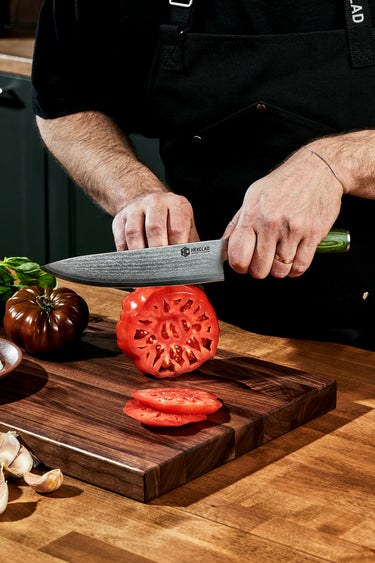How To Test Knife Sharpness at Home

When it comes to cooking, there are few things more important than using the proper ingredients with the right measurements. But did you know that a dull knife actually removes some of the nutrients from your greens and herbs?
A dull knife will do less cutting and more pushing and pulling of some of your ingredients, leaving a lot of the nutritional benefit behind on the cutting board.
Today, we are going to talk about all things knives. We will break down how you can test the cutting edge and why blade sharpness is important.
3 Easy Ways To Test Knife Sharpness at Home
If you’ve noticed that your cuts aren’t as precise or if your onions aren’t slicing all the way through, you may have a dull knife blade. Using a dull blade isn’t only frustrating; it’s dangerous. It’s much harder to maintain control of a blade that couldn’t even slice a piece of paper.
Here are three different and easy ways to test the edge of the blade.
Look To See if the Edge Reflects Light
To do this, ensure it’s daytime and you’re near a window. Hold your knife’s blade to the natural light for a visual inspection. If you don’t see any light reflecting off spots on your blade, your knife is in perfect condition.
However, if you see spots of light reflecting off the knife’s edge or other areas of the blade, you have a dull knife on your hands.
A fully intact and sharp-edged knife won’t have enough surface area to refract light, but a dulled knife will have those polished-looking spots all over the blade that catch the light and bounce it back at you.
Tap the Blade Against Your Fingernail (Gently)
You can use the fingernail test to check the sharpness of your knife’s blade.
Tap the edge of your knife very gently against the top of your fingernail or thumbnail. If the blade sits or sinks in, it’s sharp and ready to use. A dull knife will scratch and slide or bounce against the surface of your fingernail.
Try the Tomato Test
Use the cutting test to check out the condition of your knife. A perfectly sharpened blade will slide through a tomato like butter. You should be able to cut a tomato with little to no pressure from your hand with a sharp knife.
A dull knife will squash the tomato or you might need to saw at the tomato to get your blade to pierce the skin. Either way, this is the incorrect way to cut a tomato. It’s a good sign that your knife lacks a sharp blade.
Why Your Knives Need To Be Sharp
Here at HexClad, we believe in the need for sharp knives. That’s why our knives are made from Japanese Damascus steel, the ideal metal used for making kitchen knives and beyond.
Our knives are a 60 on the Rockwell Rating and are as beautiful as they are razor-sharp. Quality and edge sharpness matter in your kitchen knives.
Sharp Knives Are Safe Knives
If you have a sharp knife, you know how easily a good knife cuts through harder ingredients, like potatoes, tomatoes, or onions. If it’s been a while since you’ve had your knives sharpened, then you don’t realize how hard you’re making your life in the kitchen.
A dull knife will slip and slide on the surface of certain ingredients. It’s hazardous to your hands. With a sharp knife, you’ll slice and dice through ingredients easier and make it so much safer to cook on the regular.
Sharp Knives Save You Time in the Kitchen
Not only is it safer to make clean cuts with a sharp knife, but it will also cut time during your prep (see what we did there).
A dull knife takes a lot longer to cut ingredients and get those precision pieces you need for a standard hash or saute. So save your time and your sanity in the kitchen and keep those knives on point.
Sharp Knives Last Longer
Just like a well-cared-for pan can last a lifetime, so too does a knife that’s taken care of.
Regularly honing knives or keeping the blade centered will help prolong the sharpness, too. Most home cooks will need knife sharpening, either with a whetstone or by using a professional service twice a year.
Just like anything that requires care and attention, your knives will serve you better if you take the proper steps to keep them in killer condition.
Your Knives Need an Upgrade
We’re just going to say it: if you ended up here because it seems like your knives won’t maintain the right level of sharpness or no matter how much you’ve sharpened them, they just don’t get the job done, then it might be time to upgrade your arsenal.
We know our chef’s knife or knife set, complete with a honing tool, will get your prep done faster and your cutting jobs done safer. Your culinary skills are only as good as the tools you use. Don’t sell yourself (or your knives) short.
Sources:





